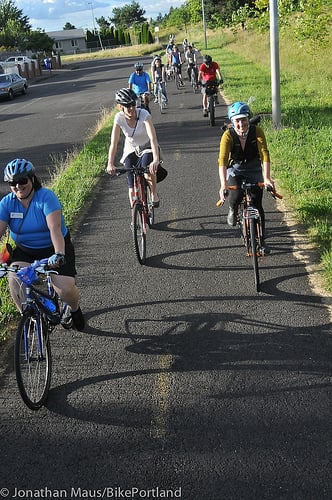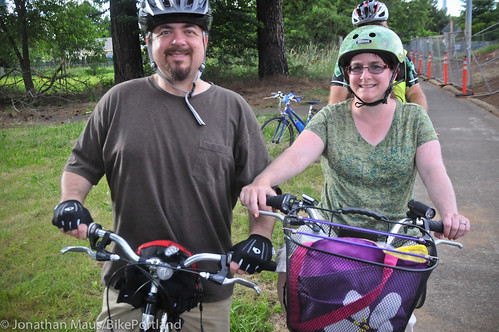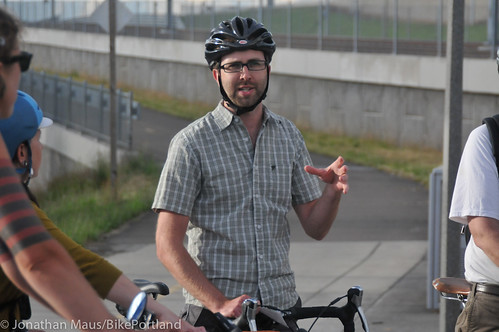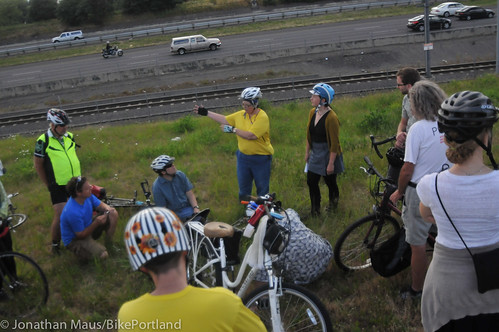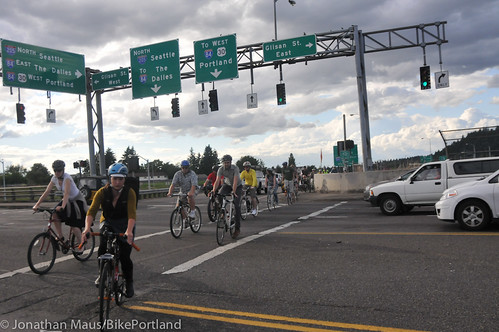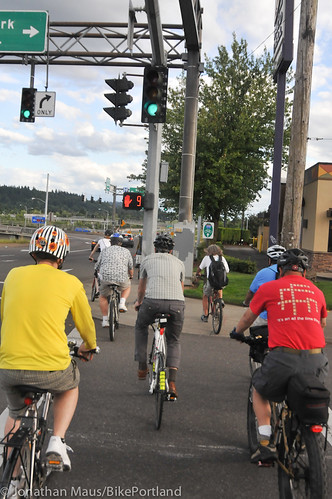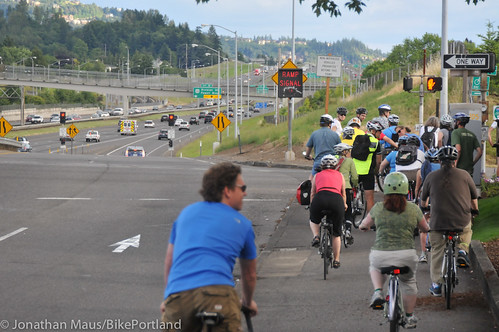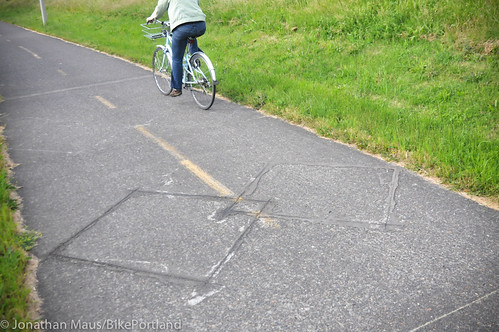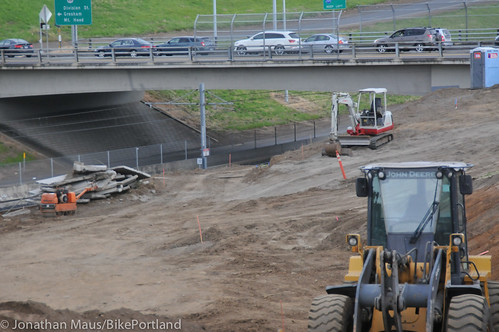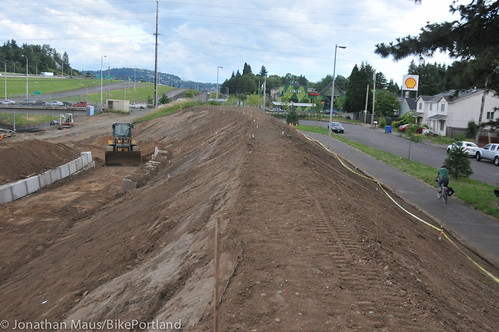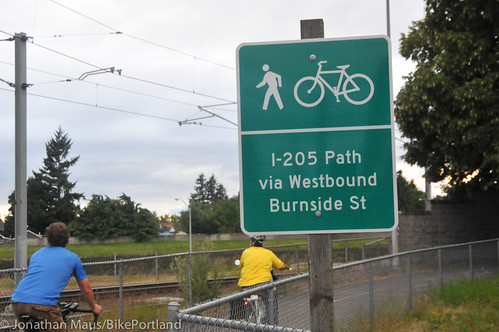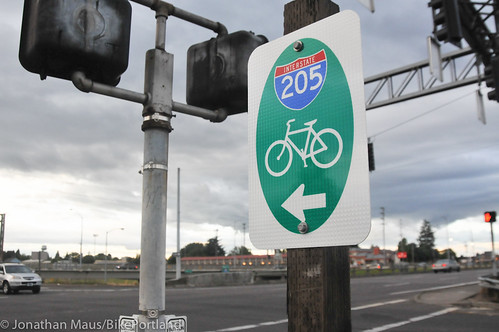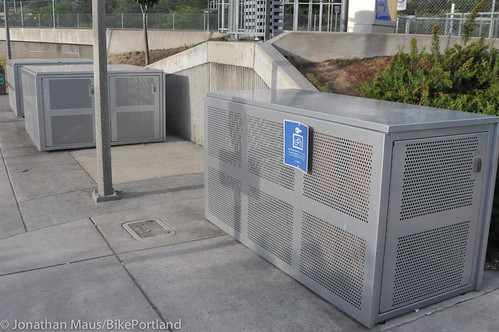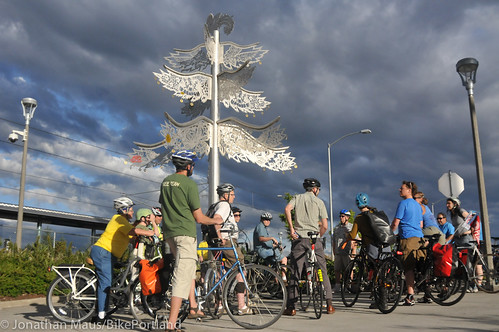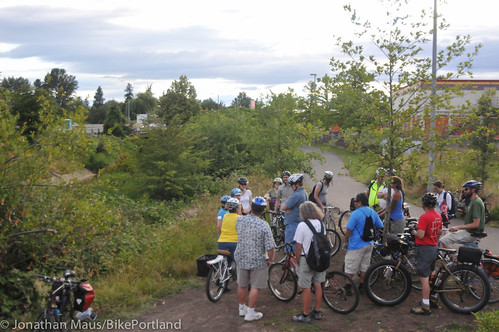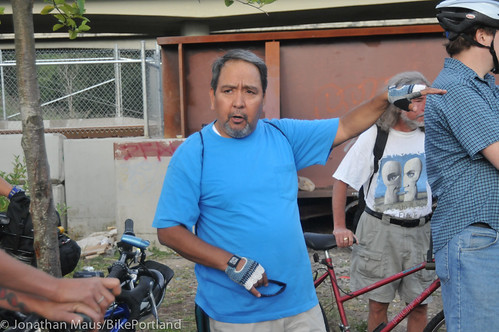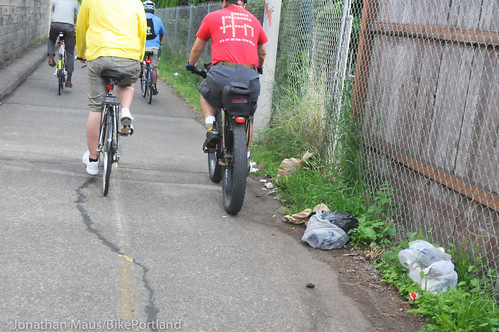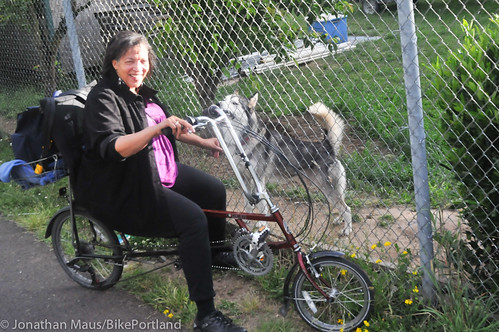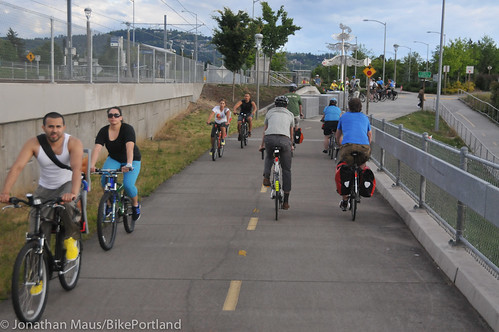When it comes to our region’s multi-use paths (known by wonks as MUPs), it’s not a stretch to call the I-205 path the “Granddaddy” of them all. Built by the Oregon Department of Transportation with money from our heralded “Bicycle Bill” (that mandates 1% of new highway funds go toward bicycling), the first section of the path opened in the 1970s and it was “completed” in 1982. Today the path connects five cities, ten neighborhoods, and stretches 16.5 miles from the Clackamas River in Gladstone to Vancouver, Washington.
Last night, staffers from ODOT and TriMet led a Pedalpalooza ride (sponsored by the Women’s Transportation Seminar) that gave attendees a chance to learn more about the path’s past, present and future.
Before we got rolling, it was fun to hear the reasons why each person showed up on a weekday evening for a wonky tour of the I-205 path. “This was the closest Pedalpalooza ride to me tonight,” said one guy. Another guy said, “I do all of the wonk rides.” We were also joined by a a married couple named Michael and Wendy. Wendy shared that they live just one block off the path. “I love having this path next to our house,” she said, “because I could re-learn how to ride a bike without cars scaring the crap out of me.”
We began at the Gateway Transit Center where TriMet active transportation planner Jeff Owen shared his agency is working with the Portland Bureau of Transportation on the East Portland Access to Transit project. Among other things, that effort will result in more bike parking at Gateway as well as a new bikeway that will connect east Portland, through the transit center, and onto the I-205 path.
We then rolled north for a stop at the future site of the Gateway Green bicycling and activity park. Neighborhood activist Linda Robinson has been working to make that project a reality since 2006. She told us they’ve now gotten the green light to start building; but they need to raise money. A fundraising campaign is set to start later this summer. (Stay tuned for more).
From Gateway Green, we rolled south and it didn’t take long before we saw just how bad many parts of the I-205 path are. The crossing of NE Glisan St. is atrocious. The path narrows and then is directed into a crosswalk that goes across six lanes of chaotic auto traffic. Then it’s up onto a sidewalk before the path starts again. I hoped we would stop at this intersection to discuss this glaring gap; but the ODOT staffer on the ride — Transit and Active Transportation Liaison Jessica Horning — conveniently kept riding. The only thing Horning said about the Glisan crossing is that, “We have partnered with PBOT to tried and figure out a solution.”
One crossing south of Glisan is another unfortunate intersection: Burnside. Here, riders must cross two sets of MAX tracks at an awkward angle while avoiding large metal bollards and then ride up onto another sidewalk before rejoining the path on the opposite (east) side of I-205. We didn’t stop to talk here either.
Then it was onto yet another less-than-great crossing: the SE Stark and Washington couplet. Here the path is once again routed into a crosswalk then onto a narrow sidewalk before rejoining the path. We didn’t stop to talk about this section either.
Finally, at SE Yamhill, Horning stopped the group to have a chat. She pointed out something rather interesting: two diamonds in the path just north of Yamhill are some of the oldest automated bicycle counters in the country. Horning shared that these inductive loops (which sense the metal in your bike and count each one that rolls over) were installed in 1982. They provided data for a few years, but then in the late 1980s, Horning said they fell victim to politics during a period of waning ODOT support for cycling and they were turned off. The good news is, they were turned back on about year ago and are once again providing accurate bicycle counts. So far, the highest date on record is August 19th 2012 when 592 bicycles rolled by. On average there are about 250 bicycles counted on this section of the path.
From Yamhill we continued south to the crossing of SE Division where we got an up-close look construction of the new undercrossing. This new section of trail will give folks the option of avoiding Division Street altogether and it’s slated to be done by this fall.
Also at the Division stop, ODOT community affairs staffer Shelli Romero told us about new wayfinding signage ODOT has installed to make the path a bit easier to navigate
At the SE Powell MAX station we heard about TriMet’s public art program and bike parking. Jeff Owen explained that for $25 per six months (and a $50 key deposit), you can gain access to any of the bike lockers at MAX stations all along the Green Line. As we stood under the “Money Tree” sculpture by Valerie Otani, Owen explained that there each Green Line stop has work from a different artist and each piece is meant to evoke something about the area’s cultural history.
Our final stop on the ride was one of the most egregious gaps on the path. It’s not as dangerous or clunky as Glisan; but the “horseshoe” route the path takes just north of Flavel (and south of the Springwater Corridor intersection) is really unfortunate. Instead of just hopping over Johnson Creek to reach the Flavel MAX Station on the other side, the path heads east to the signal at SE 92nd and Flavel before turning back (west) to the path (via a sidewalk) at the MAX station. We heard from ODOT facilities manager Basil Christopher that at least there’s something being done about this gap. ODOT has gotten a bridge project on the state’s official project list. The list hasn’t been finalized and public support is still needed to help make sure the funding comes through.
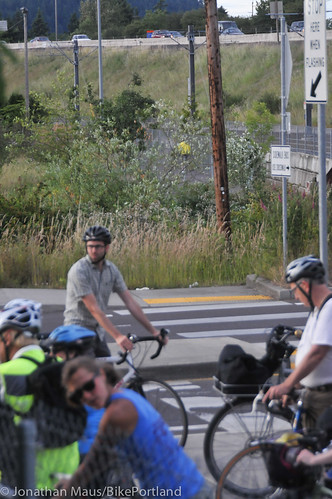
The little yellow spot in the background is a person riding on the path.
The I-205 path is a crucial connection for our bike network. In east Portland, where most of the roads are uncomfortable for cycling, it has even more value. Unfortunately, even though it’s been around for 30 years, unacceptable gaps and dangerous spots still exist. There’s also quite a bit of glass and trash in many spots. Yes, progress is being made, but it seems like there could be more urgency to make this path a real — and fully connected — bicycle corridor.
Hopefully at future Pedalpalooza rides, we’ll get to explore all the great new improvements that have been made. Until then… let’s keep pushing to make it better!
